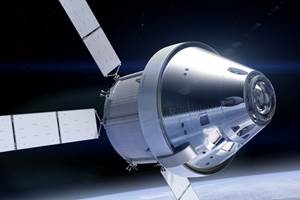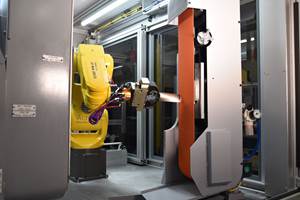AddUp’s FormUp 350 Evolution Prints Parts Up to 1 Meter Tall
The FormUp 350 Evolution machine is designed to produce large metal parts with a high level of complexity and precision, which is an ability in high demand in the aeronautics, space, defense and energy sectors.
Share
Read Next
AddUp’s FormUp 350 Evolution is a variant based on the architecture of the FormUp 350 New Generation machine which offers an increased manufacturing volume, as well as an architecture focused on reducing nonproductive time. With a print volume of 350 x 350 x 1000 mm, the FormUp 350 Evolution can print parts up to 1 m high, enabling many manufacturers to expand the spectrum of applications for laser powder bed fusion (LPBF) technology.
The smaller build volume, compared to other metal processes, has historically been one of the main limitations of laser melting machines on powder bed. With the 350 Evolution and its 185% larger volume, it becomes possible to print parts as large as combustion chambers, aircraft structural elements, missile bodies or even large-capacity heat exchangers in a single operation.
The machine includes an extension of the Z axis and a manufacturing enclosure that is nearly identical to the existing FormUp 350 New Generation machine. This enables complete compatibility of recipes and parameters to create production-scale parts with the desired properties. For industrialists already equipped with New Generation machines, users can launch production on an Evolution machine without any development effort.
The machine offers users no wait between builds with an architecture entirely focused on productivity. As printing tall parts traditionally involves long manufacturing times, AddUp engineers have worked to eliminate all nonproductive time in the 3D printing process. This machine is equipped with an extractible build chamber, which enables the manufactured part and its build chamber to be removed from the machine immediately after build completion. This is said to preserve the inert environment to guarantee part quality and powder reuse. A new platform can be placed inside the machine as soon as the previous chamber is removed, and the start of the next production can occur. The cooling of the previous build, as well as the vacuuming of the loose powder, can be carried out as a background task rather than taking up machine time, which can save several hours between productions.
The company says the 350 Evolution is a “stretched” version of the 350 New Generation, inheriting all the characteristics that have made the FormUp range so successful. Just as with the 350 New Generation, this machine offers flexibility with the choice of a roller or scraper recoating device and a number of lasers, up to 4,500 W each. Quality parts are printed with the 3-axis laser scanner capable of high-precision reach to every point on the build plate.
In addition, all laser and chamber parameters are completely open, enabling manufacturers to optimize the mechanical characteristics of parts and their surface finish. It is said the FormUp includes the highest level of safety on the market with the inclusion of an autonomous powder module and a fume filtration module that prevents the exposure of toxic or explosive substances to operators, even when using reactive powders. This also enables the powder properties to be maintained over the course of many productions, ensuring that the powder is never exposed to ambient air.
By introducing an LPBF machine with an extended height of one meter, AddUp strived to meet the real need of production-level manufacturing - to produce large parts with a high level of complexity and precision. The FormUp 350 Evolution responds to the need to make such applications profitable, pushing forward the industry of Metal 3D Printing.
- Read about Zeda’s collaboration with AddUp to support Zeda’s growth in the aerospace and medical sectors.
- Learn about Acrotec and AddUp combining their expertise to enable the development of additive and industrial solutions dedicated to the medical sector, which is constantly evolving and looking for more innovative tools.
- Here’s another AddUp partnership, this time with Interspectral for a melt pool monitoring system which reduces quality inspection costs and improves efficiency by tracking in real-time both power and emissivity drifts.
Related Content
6 Reasons Space Exploration Will Need Additive Manufacturing
There are at least half a dozen ways 3D printing will contribute to space travel, research and habitation — and in some cases it already is. Insights from seminar focused on manufacturing challenges for the space sector.
Read MoreDrones Take Flight with Metal and Polymer 3D Printed Parts: The Cool Parts Show Bonus
Drones produced by Cobra Aero now incorporate many 3D printed parts made through laser powder bed fusion and Multi Jet Fusion processes.
Read MoreAircraft Engine MRO: How Additive Manufacturing Plus Robotic Finishing Will Expand Capacity for Blade Repair
AM offers the chance to bring fast, automated processing to individualized, part-by-part restoration of turbomachinery. A cell developed by Acme Manufacturing and Optomec is able to automatically repair 85,000 unique aircraft engine blades per year.
Read MoreThis Drone Bird with 3D Printed Parts Mimics a Peregrine Falcon: The Cool Parts Show #66
The Drone Bird Company has developed aircraft that mimic birds of prey to scare off problem birds. The drones feature 3D printed fuselages made by Parts on Demand from ALM materials.
Read MoreRead Next
Hybrid Additive Manufacturing Machine Tools Continue to Make Gains (Includes Video)
The hybrid machine tool is an idea that continues to advance. Two important developments of recent years expand the possibilities for this platform.
Read MoreAt General Atomics, Do Unmanned Aerial Systems Reveal the Future of Aircraft Manufacturing?
The maker of the Predator and SkyGuardian remote aircraft can implement additive manufacturing more rapidly and widely than the makers of other types of planes. The role of 3D printing in current and future UAS components hints at how far AM can go to save cost and time in aircraft production and design.
Read More4 Ways the Education and Training Challenge Is Different for Additive Manufacturing
The advance of additive manufacturing means we need more professionals educated in AM technology.
Read More











.png;maxWidth=300;quality=90)












